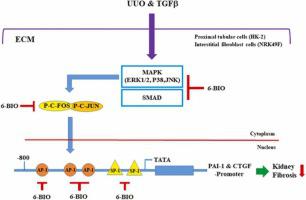Biomedicine & Pharmacotherapy ( IF 6.9 ) Pub Date : 2021-11-10 , DOI: 10.1016/j.biopha.2021.112402 Jung Sun Park 1 , In Ae Jung 1 , Hong Sang Choi 1 , Dong-Hyun Kim 1 , Hoon In Choi 1 , Eun Hui Bae 1 , Seong Kwon Ma 1 , Soo Wan Kim 1

|
PAI-1 and CTGF are overexpressed in kidney diseases and cause fibrosis of the lungs, liver, and kidneys. We used a rat model of unilateral ureteral obstruction (UUO) to investigate whether 6-BIO, a glycogen synthase kinase-3β inhibitor, attenuated fibrosis by inhibiting PAI-1 and CTGF in vivo. Additionally, TGFβ-induced cellular fibrosis was observed in vitro using the human kidney proximal tubular epithelial cells (HK-2), and rat interstitial fibroblasts (NRK49F). Expression of fibrosis-related proteins and signaling molecules such as PAI-1, CTGF, TGFβ, αSMA, SMAD, and MAPK were determined in HK-2 and NRK49F cells using immunoblotting. To identify the transcription factors that regulate the expression of PAI-1 and CTGF the promoter activities of AP-1 and SP-1 were analyzed using luciferase assays. Confocal microscopy was used to observe the co-localization of AP-1 and SP-1 to PAI-1 and CTGF. Expression of PAI-1, CTGF, TGFβ, and α-SMA increased in UUO model as well as in TGFβ-treated HK-2 and NRK49F cells. Furthermore, UUO and TGFβ treatment induced the activation of P-SMAD2/3, SMAD4, P-ERK 1/2, P-P38, and P-JNK MAPK signaling pathways. PAI-1, CTGF, AP-1 and SP-1 promoter activity increased in response to TGFβ treatment. However, treatment with 6-BIO decreased the expression of proteins and signaling pathways associated with fibrosis in UUO model as well as in TGFβ-treated HK-2 and NRK49F cells. Moreover, 6-BIO treatment attenuated the expression of PAI-1 and CTGF as well as the promoter activities of AP-1 and SP-1, thereby regulating the SMAD and MAPK signaling pathways, and subsequently exerting anti-fibrotic effects on kidney cells.
中文翻译:

6-bromo-indirubin-3'-oxime (6-BIO) 通过调节肾细胞中的激活蛋白-1 (AP-1) 和特异性蛋白-1 (SP-1) 转录因子的抗纤维化作用
PAI-1 和 CTGF 在肾脏疾病中过度表达并导致肺、肝和肾的纤维化。我们使用单侧输尿管梗阻 (UUO) 大鼠模型来研究 6-BIO(一种糖原合酶激酶 3β 抑制剂)是否通过在体内抑制 PAI-1 和 CTGF 来减轻纤维化。此外,使用人肾近端肾小管上皮细胞 (HK-2) 和大鼠间质成纤维细胞 (NRK49F) 在体外观察到 TGFβ 诱导的细胞纤维化。使用免疫印迹法测定 HK-2 和 NRK49F 细胞中纤维化相关蛋白和信号分子如 PAI-1、CTGF、TGFβ、αSMA、SMAD 和 MAPK 的表达。为了鉴定调节 PAI-1 和 CTGF 表达的转录因子,使用荧光素酶测定分析了 AP-1 和 SP-1 的启动子活性。共聚焦显微镜用于观察 AP-1 和 SP-1 与 PAI-1 和 CTGF 的共定位。在 UUO 模型以及 TGFβ 处理的 HK-2 和 NRK49F 细胞中,PAI-1、CTGF、TGFβ 和 α-SMA 的表达增加。此外,UUO 和 TGFβ 处理诱导 P-SMAD2/3、SMAD4、P-ERK 1/2、P-P38 和 P-JNK MAPK 信号通路的激活。PAI-1、CTGF、AP-1和SP-1启动子活性响应 TGFβ 处理而增加。然而,在 UUO 模型以及 TGFβ 处理的 HK-2 和 NRK49F 细胞中,6-BIO 处理降低了与纤维化相关的蛋白质和信号通路的表达。此外,6-BIO 处理减弱了 PAI-1 和 CTGF 的表达以及 AP-1 和 SP-1 的启动子活性,从而调节 SMAD 和 MAPK 信号通路,随后对肾细胞发挥抗纤维化作用。






























 京公网安备 11010802027423号
京公网安备 11010802027423号